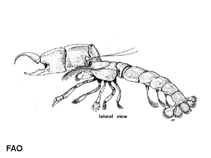Trypaea australiensis Dana, 1852
Australian ghost shrimp| Native range | All suitable habitat | Point map | Year 2050 |

|
| This map was computer-generated and has not yet been reviewed. |
| Trypaea australiensis AquaMaps Data sources: GBIF OBIS |
Classification / Names Common names | Synonyms | CoL | ITIS | WoRMS
Malacostraca | Decapoda | Callianassidae
Environment: milieu / climate zone / depth range / distribution range Ecology
Benthic; brackish. Subtropical; 18°S - 40°S, 144°E - 154°E (Ref. 4)
Distribution Countries | FAO areas | Ecosystems | Occurrences | Introductions
Indo-West Pacific: Australia.
Length at first maturity / Size / Weight / Age
Maturity: Lm ? range ? - ? cmCommon length : 6.0 cm TL male/unsexed; (Ref. 4); max. reported age: 2.00 years (Ref. 2823)
Short description Morphology
Rostrum a short, blunt and wide triangle, far overreached by the squarish eyes (almost with their full length). No antennal spine, but antennal angle low, broad and rounded. Antennular peduncle reaching with more than half the length of the third segment beyond the antennal peduncle. Third maxilliped with merus and ischium strongly widened, forming an operculum; distal three segments all narrow, each three times or more longer than wide. Large chela in adult male with deep concavity in the anterior margin of the palm just above the base of the fixed finger. Carpus about as long as the palm and slightly longer than high. Merus with a large, curved, bluntly rounded lobe in the basal part of the lower margin. Telson quadrangular, longer than wide with broadly rounded posterolateral angels, without spines. Endopod or uropod broadly oval, only slightly longer than telson (Ref. 4).
It has a total body length of 1.5 to 6 cm (Ref. 4). It is found on intertidal sand or mud flats, often in or near estuaries. They burrow in the soft substratum (Ref. 4).
Life cycle and mating behavior Maturity | Reproduction | Spawning | Eggs | Fecundity | Larvae
Members of the order Decapoda are mostly gonochoric. Mating behavior: Precopulatory courtship ritual is common (through olfactory and tactile cues); usually indirect sperm transfer.
Main reference
References | Coordinator | Collaborators
Holthuis, L.B. 1991. (Ref. 4)
IUCN Red List Status (Ref. 130435)
CITES status (Ref. 108899)
Not Evaluated
CMS (Ref. 116361)
Not Evaluated
Threat to humans
Human uses
Bait: usually
| FishSource |
Tools
More information
Internet sources
BHL | BOLD Systems | CISTI | DiscoverLife | FAO(Publication : search) | Fishipedia | GenBank (genome, nucleotide) | GloBI | Gomexsi | Google Books | Google Scholar | Google | PubMed | Tree of Life | Wikipedia (Go, Search) | Zoological Record
Estimates based on models
Preferred temperature
(Ref. 115969): 15.4 - 26, mean 24.1 (based on 129 cells).
Price category
(Ref. 80766):
Unknown.



